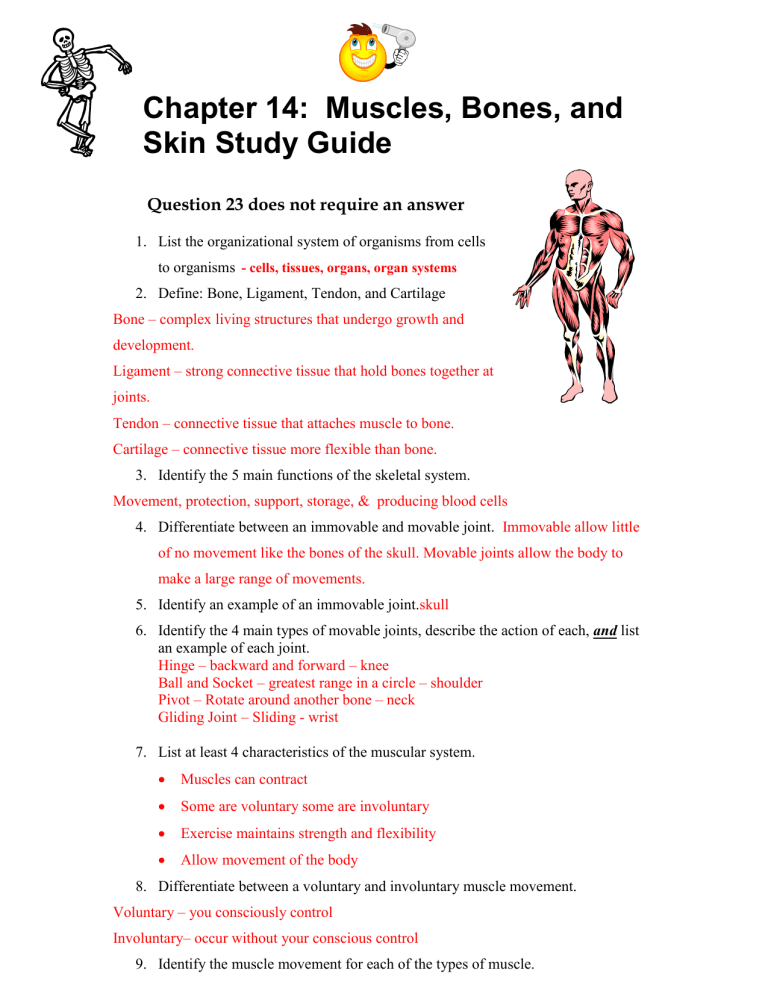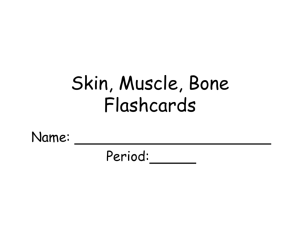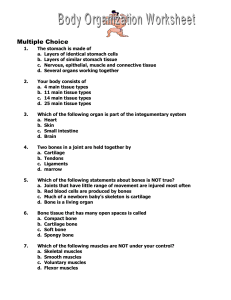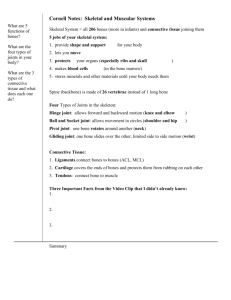Study guide ANSWER KEY

Chapter 14: Muscles, Bones, and
Skin Study Guide
Question 23 does not require an answer
1.
List the organizational system of organisms from cells to organisms - cells, tissues, organs, organ systems
2.
Define: Bone, Ligament, Tendon, and Cartilage
Bone – complex living structures that undergo growth and development.
Ligament – strong connective tissue that hold bones together at joints.
Tendon – connective tissue that attaches muscle to bone.
Cartilage – connective tissue more flexible than bone.
3.
Identify the 5 main functions of the skeletal system.
Movement, protection, support, storage, & producing blood cells
4.
Differentiate between an immovable and movable joint. Immovable allow little of no movement like the bones of the skull. Movable joints allow the body to make a large range of movements.
5.
Identify an example of an immovable joint.
skull
6.
Identify the 4 main types of movable joints, describe the action of each, and list an example of each joint.
Hinge – backward and forward – knee
Ball and Socket – greatest range in a circle – shoulder
Pivot – Rotate around another bone – neck
Gliding Joint – Sliding - wrist
7.
List at least 4 characteristics of the muscular system.
Muscles can contract
Some are voluntary some are involuntary
Exercise maintains strength and flexibility
Allow movement of the body
8.
Differentiate between a voluntary and involuntary muscle movement.
Voluntary – you consciously control
Involuntary– occur without your conscious control
9.
Identify the muscle movement for each of the types of muscle.
Skeletal – voluntary
Smooth - involunary
Cardiac - involuntary
10.
What muscles tire easily? What muscles have a quick reaction?.
skeletal; skeletal
11.
Why do skeletal muscles work in pairs?
because muscle cells can only contract not extend
12.
Explain the statement, “Muscles only pull, never push.” they can only pull the bone when the contract, cant extend and push a bone
13.
How does the skin protect the body from disease?
it forms a barrier between the inside and outside of the body
14.
In which layer of the skin would you find nerves and blood vessels.__
dermis _________
15.
Define homeostasis?__
body’s ability to maintain stable internal conditions despite external conditions ____________
16.
Your internal body temperature will always be about __ 37 ____C
17.
What is the function of melanin besides giving the skin pigment
(color)?_____
protect skin from burning _______________________________________
18.
How does the skin help regulate body temperature?____
sweat glands and perspiration ____________________
19.
Dairy products are good for your bones because they contain the mineral
_ calcium _________ which helps prevent osteoporosis.
19. Another name for the cranium is the _ skull ______________.
20. A baby’s skeleton is made of mostly ____ cartilage _______________.
*21. You must be able to label the 21 bones of the skeleton. Practice below :
22. Draw a picture of cardiac, smooth, and skeletal muscle below
(pg. 483)
23 You must be able to label specific muscles: biceps, deltoids, quadriceps, gluteus maximus, triceps, pectoral muscles, sartorius, and gastrocnemius
.











